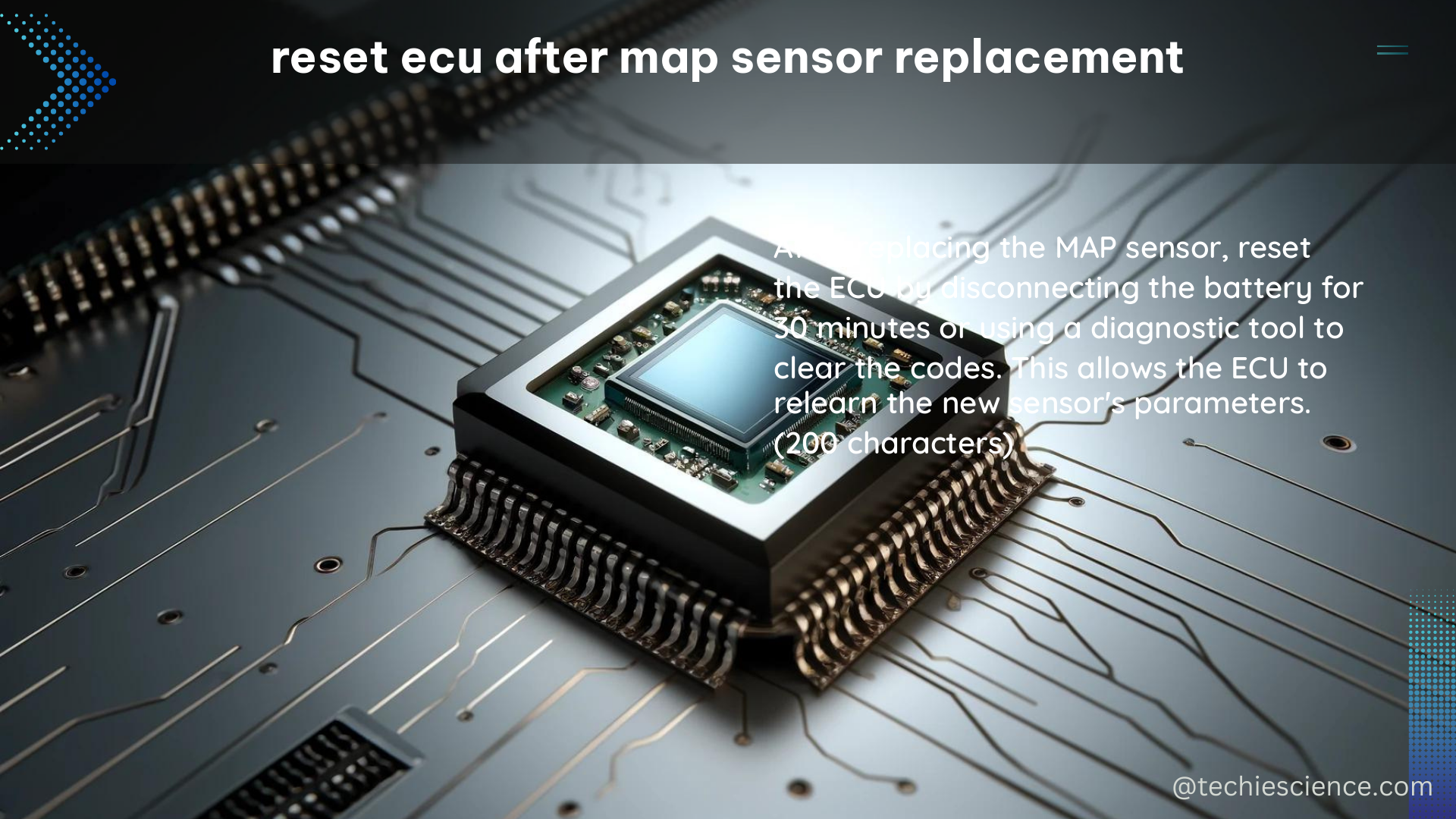Resetting the Engine Control Unit (ECU) after replacing the Manifold Absolute Pressure (MAP) sensor is a crucial step in ensuring your vehicle’s optimal performance. This comprehensive guide will walk you through the various methods, considerations, and technical details involved in the process.
Understanding the Importance of ECU Reset
The ECU is the brain of your vehicle, responsible for managing various engine functions, including fuel injection, ignition timing, and emissions control. When you replace the MAP sensor, the ECU needs to recalibrate and learn the new sensor’s characteristics to maintain proper engine operation.
Failing to reset the ECU after a MAP sensor replacement can lead to a range of issues, such as:
- Inaccurate fuel-air mixture calculations
- Erratic engine performance
- Increased fuel consumption
- Illumination of the Check Engine Light (CEL)
- Potential long-term damage to the engine or other components
Methods for Resetting the ECU

There are several methods you can use to reset the ECU after replacing the MAP sensor. The choice of method may depend on the specific make and model of your vehicle, as well as the availability of diagnostic tools.
Method 1: Battery Disconnect
One of the most common methods for resetting the ECU is to disconnect the vehicle’s battery for a specific period of time. This method works by removing power from the ECU, allowing it to reset and clear any stored data or learned parameters.
Steps:
1. Locate the vehicle’s battery, typically under the hood or in the trunk.
2. Using a wrench, disconnect the negative (-) battery terminal.
3. Wait for at least 60 minutes (1 hour) to allow the ECU to fully reset.
4. Reconnect the negative battery terminal, ensuring a secure connection.
5. Start the engine and allow it to idle for a few minutes to allow the ECU to relearn the new MAP sensor.
Considerations:
– The recommended wait time may vary depending on the vehicle, with some sources suggesting up to 24 hours for a complete reset.
– Disconnecting the battery may reset other vehicle systems, such as the clock, radio presets, and engine control module adaptations, which may need to be reconfigured.
Method 2: Scan Tool Reset
If you have access to a diagnostic scan tool, you can use it to directly reset the ECU and clear any stored codes or learned parameters.
Steps:
1. Connect the scan tool to the vehicle’s On-Board Diagnostic (OBD) port, typically located under the dashboard.
2. Navigate to the ECU reset or “relearn” function on the scan tool.
3. Follow the on-screen instructions to initiate the ECU reset process.
4. Once the reset is complete, start the engine and allow it to idle for a few minutes to allow the ECU to relearn the new MAP sensor.
Considerations:
– The specific steps may vary depending on the scan tool and the vehicle’s make and model.
– Some vehicles may require a specific reset procedure or sequence to be followed, which can be found in the vehicle’s service manual or manufacturer’s instructions.
Method 3: Driving Relearn
In some cases, the ECU may be able to relearn the new MAP sensor through normal driving conditions, without the need for a specific reset procedure.
Steps:
1. Start the engine and allow it to idle for a few minutes.
2. Drive the vehicle for a distance of at least 30 miles (48 km) or until the Check Engine Light (CEL) turns off.
3. During the drive, ensure the engine is under various load conditions, such as accelerating, cruising, and decelerating.
Considerations:
– The time and distance required for the ECU to relearn the new MAP sensor may vary depending on the vehicle and driving conditions.
– This method may not be suitable for all vehicles or situations, and a more direct reset procedure may be necessary.
Verifying the ECU Reset
After resetting the ECU, it’s important to verify that the process was successful and the ECU has properly relearned the new MAP sensor.
Verification Steps:
1. Check for any illuminated warning lights, such as the Check Engine Light (CEL), on the vehicle’s dashboard.
2. Use a diagnostic scan tool to check for any diagnostic trouble codes (DTCs) related to the MAP sensor or engine performance.
3. Monitor the vehicle’s performance, including fuel efficiency, engine responsiveness, and any noticeable changes in drivability.
If the vehicle is still experiencing issues or the Check Engine Light remains illuminated, it may be necessary to repeat the reset process or seek further diagnostic assistance from a qualified automotive technician.
Conclusion
Resetting the ECU after replacing the MAP sensor is a crucial step in maintaining your vehicle’s optimal performance and preventing potential long-term issues. By following the methods and considerations outlined in this comprehensive guide, you can ensure a successful ECU reset and a smooth transition to the new MAP sensor.
Remember, always refer to your vehicle’s service manual or manufacturer’s instructions for specific reset procedures and guidelines, as they may vary depending on the make, model, and year of your vehicle.
References:
- Forte Forums – Will my ECU relearn by itself after replacing the MAP sensor?
- Alfa Owner – MAP sensor cleaned, is an ECU reset needed?
- Maxima.org – ECU re-learn time
- Honda-Tech – Fixed problem, but now “Check Engine” light stays and gives code 3
- MyG37.com – PO106 can’t be fixed

The lambdageeks.com Core SME Team is a group of experienced subject matter experts from diverse scientific and technical fields including Physics, Chemistry, Technology,Electronics & Electrical Engineering, Automotive, Mechanical Engineering. Our team collaborates to create high-quality, well-researched articles on a wide range of science and technology topics for the lambdageeks.com website.
All Our Senior SME are having more than 7 Years of experience in the respective fields . They are either Working Industry Professionals or assocaited With different Universities. Refer Our Authors Page to get to know About our Core SMEs.